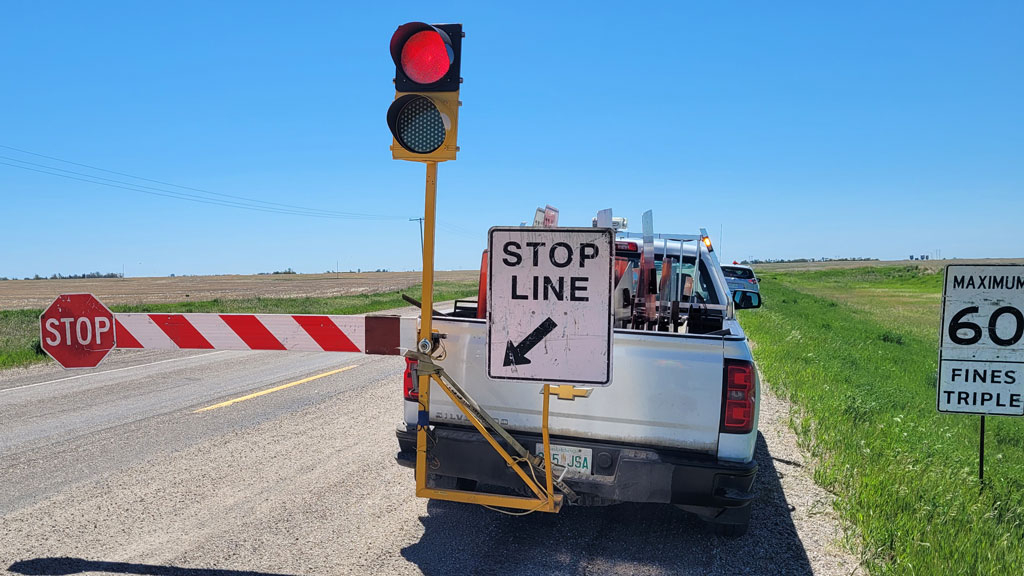Nine years ago, construction flag woman Ashley Dawn Richards was on the job on Highway 39 near Midale, Sask., about a two-hour drive southeast of Regina.
It was her second day on the job. She was flagging for the first time. Tragically, just three hours into her shift, the 18-year-old was struck and killed by a truck.
Her death prompted a Saskatchewan company to develop a new system to make construction zones safer.
Watrous-based entrepreneurs Kim and Donna Kreutzer started Guardian Angel Auto Flagger Manufacturing and developed a remote-controlled Guardian Angel automatic flagging assistance device (AFAD).
The device is mounted on the hitch of a pickup truck and allows flag people to be off the road while controlling traffic and minimizing their risk of injury. The truck is parked safely on the shoulder of the road and the flagger remotely operates a traffic light and stop arm with a stop sign from a safe location off the road.
The device weighs 90 pounds, takes minutes to set up, and can be plugged into a two-inch receiver on a truck.
The AFADs are being tested this year as part of a new pilot program underway in the province. Six devices are operating in work zones in the Moose Jaw, Outlook and Prince Albert areas.
The units are being tested at the various locations and used in a number of different work applications.
“Flag persons face the risk of being struck by a vehicle when on the roadway physically directing and controlling traffic,” explains Patrick Book, senior communications consultant at the Saskatchewan Ministry of Highways. “Anyone being in close proximity to vehicles, especially on highways, faces a high risk.”
He noted in late July, an alleged drunk driver swerved through a construction site on Highway 16 near Maymont at high speed. The motorist nearly hit a flag worker before crashing into a ditch.
“It only takes one incident to threaten the well-being of a flagger and everyone else on the job,” Book notes. “This incident underlines the impact these devices can have on improving site safety.”
Book says the ministry decided to try out the AFADs because it was looking for a solution to mitigate the risk and remove flag persons from danger.
“We learned about the truck mounted AFADs and the benefits it presented made it a good option to trial.”
The pilot began in June and will be completed at the end of the year.
Flag persons serve a necessary role on worksites, but motorists often fail to heed signs and other warnings, says Book.
“Remote controlled AFADs allow the operator to control traffic without being on the road surface, taking them out of the path of oncoming traffic and drastically reducing the risk these workers face.”
Trailer-mounted or standalone AFAD models have been used for larger construction sites, but their size and weight make them more difficult to move. The Guardian Angel models are ideal for projects like maintenance where workers are moving frequently because the truck can simply be driven forward as needed.
“This makes them more efficient for sites where crews are continually moving and means less potential for injury compared to other standalone or trailer-mounted AFADs that require lifting or connecting a trailer hitch to move,” says Book.
Like any other pilot, the use of the AFADs will be evaluated. In particular, provincial officials will take into account the number of near misses that occur in work zones using the device, the number of miscommunication incidents, and feedback from flaggers.
Early results on the AFADs are favourable, with no reports of vehicles ignoring the device and entering active work zones. Workers have also reported they feel safer.
The couple who created the AFAD were entrepreneurs who wanted to make a difference. The death of Richards hit close to home for them as the Kreutzers have several family members and friends that risk their lives daily on Saskatchewan roads. Their vision is to keep those working in roadside construction zones safe.
“We were determined to create a high quality, easy-to-use device that would eliminate the danger of collision with roadside flaggers and emergency crews,” says Guardian Angel marketing manager Edward Anderson. “Our goal is that all flaggers and emergency crews make it home to their families each night.”
The Government of Saskatchewan is improving more than 1,350 kilometres of provincial highways in 2021. This year is the second of its 10-year Growth Plan goal to build and upgrade 10,000 kilometres of highways. Since 2008, work has been completed on more than 17,100 kilometres of highways in the province.
Provincial Highways Minister Fred Bradshaw told media at an event west of Moose Jaw recently that flag persons often have close calls with motorists who do not slow down or pay attention while travelling through work zones.
“Being able to take workers off the road and away from traffic helps negate the very real danger that is present every minute of each shift,” he says.











Recent Comments